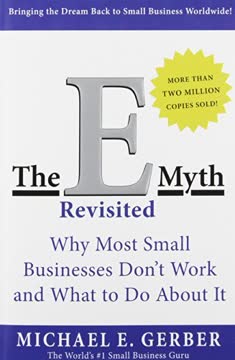Key Takeaways
1. The E-Myth: Most small businesses fail due to the Entrepreneurial Myth
The E-Myth is the myth of the entrepreneur. It runs deep in this country and rings of the heroic.
The Entrepreneurial Myth is the mistaken belief that most businesses are started by entrepreneurs with business knowledge. In reality, most are started by technicians who know how to do the work but lack business skills. This leads to failure because:
- Technical skills alone are insufficient for running a successful business
- Many business owners work in their business rather than on it
- The owner becomes overwhelmed trying to do everything themselves
The E-Myth explains why 40% of new businesses fail within the first year, and 80% fail within five years. To succeed, business owners must shift their focus from working in the business to working on the business.
2. The Entrepreneur, The Manager, and The Technician: Three personalities in every business owner
The Entrepreneur lives in the future, never in the past, rarely in the present. He's happiest when left free to construct images of "what-if" and "if-when."
Every business owner has three personalities:
-
The Entrepreneur: The visionary and dreamer
- Sees opportunities and sets direction
- Craves control and creates change
-
The Manager: The pragmatic planner
- Craves order and creates systems
- Organizes and maintains structure
-
The Technician: The doer and worker
- Focuses on the present and getting things done
- Comfortable with routine and hands-on work
Most small business owners are 10% Entrepreneur, 20% Manager, and 70% Technician. This imbalance leads to problems as the business grows. Success requires balancing these personalities and developing the Entrepreneurial and Managerial aspects.
3. Business Development Process: Work on your business, not in it
Your business is not your life.
Working on your business means:
- Treating your business as a product to be developed
- Creating systems that allow the business to run without you
- Focusing on strategic work rather than technical work
To achieve this:
- Develop a Business Development Program
- Create a Franchise Prototype (even if you don't plan to franchise)
- Implement systems for every aspect of your business
- Document all processes in Operations Manuals
This approach allows you to:
- Build a business that can be replicated
- Create value beyond your personal efforts
- Achieve freedom from day-to-day operations
4. The Turn-Key Revolution: Franchising as a model for success
The true product of a business is the business itself.
The Turn-Key Revolution, exemplified by Ray Kroc's McDonald's, demonstrates:
- The power of creating a business system that can be replicated
- The importance of consistency and standardization
- The value of focusing on the business model, not just the product
Key aspects of the franchise model:
- Documented systems and processes
- Standardized operations
- Focus on replicability and scalability
Even if you don't plan to franchise, adopting this mindset can:
- Increase business value
- Improve efficiency and consistency
- Allow for easier expansion and growth
5. Your Primary Aim: Define your personal vision and life goals
What do I wish my life to look like?
Your Primary Aim is your personal vision for your life, encompassing:
- Your values and priorities
- The impact you want to make
- How you want to be remembered
To develop your Primary Aim:
- Visualize your ideal life
- Define your personal and professional goals
- Identify your core values and principles
Your Primary Aim should:
- Guide your business decisions
- Align your business with your personal aspirations
- Provide motivation and purpose beyond financial success
6. Your Strategic Objective: Create a clear vision for your business
How can I get my business to work, but without me?
Your Strategic Objective is a clear statement of what your business must ultimately do to achieve your Primary Aim. It includes:
-
Financial goals:
- Gross revenues
- Profits
- Return on investment
-
Business model:
- Type of business
- Target market
- Unique selling proposition
-
Standards and benchmarks:
- Quality standards
- Customer service expectations
- Operational metrics
Your Strategic Objective should be:
- Specific and measurable
- Aligned with your Primary Aim
- Focused on creating a business that works without you
7. Organizational Strategy: Develop a structure that supports growth
Your Organization Chart flows down from your Strategic Objective, which in turn flows down from your Primary Aim.
Create an Organizational Strategy by:
-
Developing an Organization Chart:
- Define all positions needed for a fully functioning business
- Include positions for future growth, not just current needs
-
Creating Position Contracts:
- Clearly define responsibilities and accountabilities for each position
- Set standards and expectations for performance
-
Implementing a prototype approach:
- Start by filling all positions yourself
- Document and systemize each role
- Gradually replace yourself with employees or systems
This approach allows you to:
- Understand all aspects of your business
- Create scalable systems and processes
- Build a business that can operate without you
8. Management Strategy: Create systems, not rely on skilled people
The System is the Solution.
Develop a Management Strategy focused on systems:
-
Create a Management System:
- Standardize decision-making processes
- Implement consistent policies and procedures
- Develop metrics and tracking systems
-
Focus on orchestration:
- Eliminate discretion at the operational level
- Create predictable, repeatable processes
- Ensure consistency in customer experience
-
Implement continuous improvement:
- Regularly review and update systems
- Encourage employee feedback on processes
- Stay adaptable to changing market conditions
This approach allows you to:
- Reduce reliance on highly skilled individuals
- Maintain consistency as you grow
- Improve efficiency and reduce errors
9. People Strategy: Cultivate a game worth playing for your employees
People do not simply want to work for exciting people. They want to work for people who have created a clearly defined structure for acting in the world.
Develop a People Strategy that:
-
Creates a compelling company culture:
- Define your company's values and mission
- Establish clear rules and expectations
- Foster a sense of purpose beyond profit
-
Implements effective training and development:
- Create standardized training programs
- Provide clear career paths and growth opportunities
- Encourage continuous learning and improvement
-
Aligns individual goals with company objectives:
- Set clear performance expectations
- Implement regular feedback and review processes
- Reward alignment with company values and goals
This approach helps:
- Attract and retain quality employees
- Increase engagement and productivity
- Create a positive work environment that supports your business goals
10. Marketing Strategy: Understand your customer's unconscious needs
Reality only exists in someone's perceptions, attitudes, beliefs, conclusions—whatever you wish to call those positions of the mind from which all expectations arise—and nowhere else.
Develop a Marketing Strategy based on:
-
Understanding your customer:
- Define your target demographic
- Research psychographic factors (attitudes, beliefs, values)
- Identify unconscious needs and desires
-
Creating a compelling brand:
- Develop a unique selling proposition
- Design visuals and messaging that resonate with your target market
- Consistently communicate your brand across all touchpoints
-
Implementing a systematic approach to marketing:
- Develop repeatable processes for lead generation
- Create systems for converting leads to customers
- Establish metrics to track and improve marketing effectiveness
This approach allows you to:
- Connect more deeply with your target market
- Create marketing messages that resonate on an emotional level
- Develop a consistent and effective marketing system
11. Systems Strategy: Implement Hard, Soft, and Information Systems
A system is a set of things, actions, ideas, and information that interact with each other, and in so doing, alter other systems.
Develop a Systems Strategy that incorporates:
-
Hard Systems:
- Physical components of your business (equipment, facilities, etc.)
- Standardized tools and resources
- Automated processes where possible
-
Soft Systems:
- People-oriented processes (hiring, training, customer service)
- Company culture and values
- Decision-making frameworks
-
Information Systems:
- Data collection and analysis tools
- Performance tracking and reporting
- Financial management systems
Integrating these systems allows you to:
- Create a more efficient and consistent operation
- Reduce reliance on individual performance
- Make data-driven decisions for continuous improvement
Implement your Systems Strategy through:
- Documenting all processes in Operations Manuals
- Regular training and reinforcement of systems
- Continuous review and improvement of all systems
Last updated:
FAQ
What's "The E-Myth Revisited" about?
- Small Business Challenges: "The E-Myth Revisited" by Michael E. Gerber explores why most small businesses fail and what can be done to prevent it. It debunks the myth that most businesses are started by entrepreneurs.
- Three Personalities: The book introduces the concept of the Entrepreneur, Manager, and Technician, explaining how these roles conflict within a small business owner.
- Business Development: It emphasizes the importance of working on your business, not just in it, by developing systems that allow the business to function without the owner’s constant involvement.
- Franchise Prototype: Gerber advocates for creating a business model that can be replicated, similar to a franchise, to ensure consistency and success.
Why should I read "The E-Myth Revisited"?
- Practical Advice: The book offers practical advice for small business owners to transform their businesses into efficient, systematized operations.
- Understanding Roles: It helps readers understand the different roles they play in their business and how to balance them effectively.
- Long-term Success: Gerber provides strategies for achieving long-term success by focusing on systems and processes rather than just the product or service.
- Inspiration and Motivation: The book is both inspirational and motivational, encouraging business owners to rethink their approach and reignite their passion for their business.
What are the key takeaways of "The E-Myth Revisited"?
- Work on Your Business: Focus on building systems that allow your business to run without you, rather than being trapped in day-to-day operations.
- Balance Roles: Recognize and balance the roles of Entrepreneur, Manager, and Technician within yourself to avoid internal conflict and business failure.
- Franchise Model: Develop your business as a prototype that can be replicated, ensuring consistency and quality in every aspect.
- Customer Focus: Understand your customer’s needs and design your business to meet those needs consistently and predictably.
What is the Entrepreneurial Myth according to Michael E. Gerber?
- Misconception: The Entrepreneurial Myth, or E-Myth, is the false belief that most businesses are started by entrepreneurs with a clear vision and plan.
- Reality: In reality, most businesses are started by technicians who are skilled at a particular task but lack the entrepreneurial skills to run a business.
- Consequences: This misconception leads to business owners being overwhelmed by the demands of running a business, often resulting in failure.
- Solution: Gerber suggests that understanding and addressing this myth is crucial for creating a successful business.
How does Michael E. Gerber define the roles of Entrepreneur, Manager, and Technician?
- Entrepreneur: The visionary who focuses on the future and innovation, driving change and growth within the business.
- Manager: The organizer who creates order and systems, ensuring that the business runs smoothly and efficiently.
- Technician: The doer who focuses on the present, performing the technical work that the business is built upon.
- Conflict: These roles often conflict within a business owner, leading to chaos if not properly balanced and managed.
What is the Franchise Prototype model in "The E-Myth Revisited"?
- Systematization: The Franchise Prototype model involves creating a business system that can be replicated consistently, much like a franchise.
- Predictability: It ensures that every aspect of the business is predictable and can deliver the same quality and experience to every customer.
- Scalability: By developing a prototype, the business can be scaled and expanded without losing its core values and quality.
- Focus on Process: The model emphasizes the importance of focusing on how the business operates, not just what it sells.
What is the Business Development Process in "The E-Myth Revisited"?
- Three Components: The Business Development Process consists of Innovation, Quantification, and Orchestration.
- Innovation: Continuously improving and finding better ways to do things within the business.
- Quantification: Measuring the impact of innovations to ensure they are effective and contribute to the business’s success.
- Orchestration: Creating systems that eliminate discretion at the operational level, ensuring consistency and reliability.
How does "The E-Myth Revisited" suggest handling management and people?
- Management System: Develop a management system that focuses on processes rather than relying on highly skilled individuals.
- Training and Development: Train employees to follow systems and processes, ensuring that the business can operate smoothly without constant supervision.
- Empowerment: Empower employees by providing them with clear guidelines and expectations, allowing them to perform their roles effectively.
- Consistency: Ensure that all employees understand and adhere to the business’s systems to maintain consistency and quality.
What marketing strategies does Michael E. Gerber recommend in "The E-Myth Revisited"?
- Customer Focus: Understand your customer’s needs and design your business to meet those needs consistently.
- Demographics and Psychographics: Use demographic and psychographic data to tailor your marketing efforts and reach your target audience effectively.
- Integrated Process: View marketing as an integrated process that includes lead generation, conversion, and client fulfillment.
- Differentiation: Differentiate your business by delivering a unique and consistent experience that sets you apart from competitors.
What are the best quotes from "The E-Myth Revisited" and what do they mean?
- "Work on your business, not in it." This quote emphasizes the importance of developing systems that allow the business to function independently of the owner.
- "The problem is not your business; the problem is you." Gerber highlights the need for business owners to change their mindset and approach to achieve success.
- "Your business is nothing more than a distinct reflection of who you are." This quote underscores the idea that a business reflects the owner’s values, skills, and vision.
- "The system is the solution." Gerber stresses that creating effective systems is the key to solving business problems and achieving consistent results.
How does "The E-Myth Revisited" address the concept of systems in business?
- Three Types of Systems: The book identifies three types of systems: Hard Systems, Soft Systems, and Information Systems.
- Integration: These systems must be integrated to create a cohesive and efficient business operation.
- Hard Systems: Physical components like equipment and facilities that support business operations.
- Soft Systems: Processes and procedures that guide how work is done, including scripts and training programs.
What is the significance of the Primary Aim in "The E-Myth Revisited"?
- Life Vision: The Primary Aim is about defining what you want your life to look like and how your business will support that vision.
- Purpose and Direction: It provides purpose and direction, ensuring that your business aligns with your personal goals and values.
- Decision-Making: Having a clear Primary Aim helps in making decisions that are consistent with your long-term objectives.
- Foundation: It serves as the foundation for all business strategies and decisions, ensuring that the business serves your life, not the other way around.
Review Summary
The E-Myth Revisited receives mixed reviews. Many praise its insights on small business management, emphasizing the importance of systems, working on rather than in the business, and the distinction between technician, manager, and entrepreneur roles. Readers find value in its advice on business development and franchising concepts. However, critics argue the book is repetitive, outdated, and poorly written, with some finding the fictional case study and dialogue annoying. Despite these criticisms, many still consider it a must-read for entrepreneurs and small business owners.
Similar Books

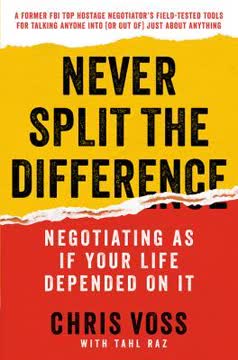

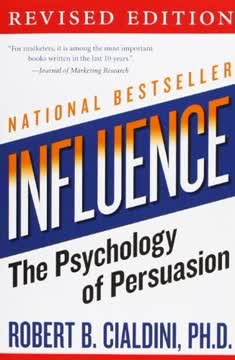


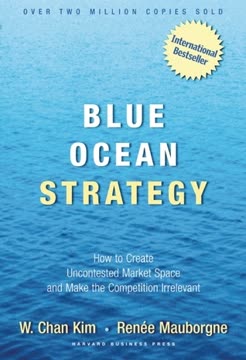

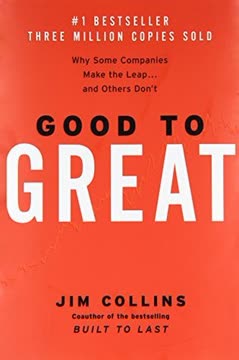
Download PDF
Download EPUB
.epub digital book format is ideal for reading ebooks on phones, tablets, and e-readers.
